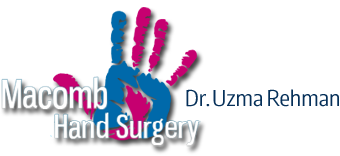Ulnar Nerve Neuropathy
Also called Ulnar nerve entrapment, this condition is an inflammation of the ulnar nerve, which controls the muscles in the forearm and hand. This allows the feeling of touch, texture and temperature throughout most of the hand and forearm. Ulnar nerve neuropathy is often caused by the nerve being compressed (or pinched) as it goes through the supporting structures of the elbow, wrist and arm. The most common type of Ulnar nerve entrapment happens at the elbow and is called cubital tunnel syndrome, which is an area of tissue through which the nerve passes. Ulnar neuropathy can also occur at the wrist, and is similar to carpal tunnel syndrome. This, however, is called Guyon’s Canal syndrome (or Guyon’s Tunnel syndrome), as it involves a completely different nerve and supporting structure.
Symptoms of Ulnar Neuropathy
When the Ulnar nerve is damaged, patients may experience pain, numbness and weakness, including varying degrees of numbness or “pins and needles” sensation from the elbow down through the fingers. Sometimes this sensation of numbness is only in the little and ring fingers of the hand. This numbness happens more often when the elbow is bent, and often times occurs at night when the elbow is bent during sleep. Ulnar nerve neuropathy can be quite painful, but most commonly is only annoying. Inability to spread the fingers apart and weakening of the grip are the most common forms of muscle weakness seen in Ulnar nerve neuropathy and can result in difficulty with finger coordination.
Ulnar Nerve Entrapment Treatment
Ulnar entrapment can usually be treated through conservative methods that include one or more of the following:
- Anti-inflammatory medication
- Corticosteroid injections
- Bracing or splinting, especially at night, to keep your elbow in a straight position
- Exercises
These treatments are usually effective in relieving symptoms. Ulnar nerve neuropathy caused by other conditions can often be relieved by treating the underlying cause.
Ulnar Nerve Surgery
Typically non-surgical treatment is recommended for Ulnar neuropathy, but severe cases may require surgery. The procedure is typically done as outpatient surgery, and most patients go home the same day. Depending upon the severity and type of Ulnar neuropathy, surgery may involve:
Cubital tunnel release. This surgery involves cutting of the cubital tunnel, allowing more room for the nerve to pass through. Once cut, new tissue grows over the gap, allowing more space for the Ulnar nerve to move. This surgery works best when the nerve compression is mild and the nerve does not slide out from behind the bony ridge of the medial epicondyle when the elbow is bent.
You may need to wear a splint for a few weeks after the operation. Physical therapy exercises may also be recommended to help you regain strength and motion in your arm.
Preventing Ulnar Entrapment
As with any condition, seeking medical attention is often the most important step in preventing the onset of symptoms. Also, paying attention to the symptoms and taking preventative measures can help alleviate the onset of Ulnar neuropathy. These include:
- Avoid keeping your arm bent for long periods of time.
- If you use a computer, do not rest your elbow on the arm rest of your chair. Make sure that your chair is not too low so that your arm is at the proper angle.
- Avoid leaning on your elbow or putting pressure on the inside of your arm.
- Do not drive with your arm resting on the open window or leaning your elbow on the arm rest.
- Keep your elbow straight at night when you are sleeping. You may want to wrap towel around your elbow or wear an elbow pad backwards to keep from bending the arm as you sleep.
If you are experiencing hand or wrist pain, contact Dr. Rehman for a comprehensive evaluation and consultation. As with most medical conditions, early detection, awareness and a prevention or treatment plan is the most effective way to combat the effects of conditions like Ulnar nerve neuropathy.
Macomb County Ulnar Nerve Neuropathy Doctor: 586.532.0803

Hand Conditions We Treat:
· Carpal Tunnel Syndrome
· CMC and Thumb Arthritis
· DeQuervain’s Disease
· Dupuytrens Contracture
· Fingernail Infection
· Ganglion Cysts
· Hand, Wrist, Finger Fracture
· Hand, Wrist or Finger Pain
· Tendonitis
· Tendons and Nerves
· Tennis Elbow
· Trigger Finger
· Ulnar Nerve Neuropathy
· Dislocations
· Sprains and Strains
· Phalanx & Fingertip Injuries
· Crush Injuries
· Tissue Loss Amputations
· Extensor Tendons
· Flexor Tendons
· Scar Management
· Nerve Compression
· Joint Replacements
· Sports Injuries
· Replants
· Any Hand or Wrist Injury



